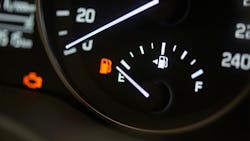New U.S. fuel economy standards for model years 2027-2031
The National Highway Traffic Safety Administration has new fuel economy standards for pickup trucks, vans, and passenger vehicles.
The final rule, the latest in federal transportation efficiency efforts, calls for pickup truck and van fuel efficiency to increase 10% per year for model years 2030-2032 and 8% per year for model years 2033-2035. This would result in a U.S. fleetwide average of about 35 mpg by model year 2035.
The fuel economy of passenger cars would increase 2% per year for model years 2027-2031, while that of light trucks will increase 2% per year for model years 2029-2031. These increases would bring the average light-duty vehicle fuel economy up to about 50.4 mpg by model year 2031.
“Not only will these new standards save Americans money at the pump every time they fill up, they will also decrease harmful pollution and make America less reliant on foreign oil,” U.S. Transportation Secretary Pete Buttigieg said. “These standards will save car owners more than $600 in gasoline costs over the lifetime of their vehicle.”
NHTSA said the new standards will save almost 70 billion gallons of gasoline by 2050 and prevent more than 710 million metric tons of carbon dioxide emissions.
“When Congress established the Corporate Average Fuel Economy program in the 1970s, the average vehicle got about 13 miles to the gallon. Under these new standards, the average light-duty vehicle will achieve nearly four times that at 50 miles per gallon,” NHTSA Deputy Administrator Sophie Shulman said. “These new fuel economy standards will save our nation billions of dollars, help reduce our dependence on fossil fuels, and make our air cleaner for everyone. Americans will enjoy the benefits of this rule for decades to come.”
NHTSA’s new fuel economy standards complement the Environmental Protection Agency’s emissions standards for similar vehicle fleets. NHTSA worked with the EPA to optimize the effectiveness of its standards while minimizing compliance costs.
Though NHTSA does not consider electric and other alternative fuels when setting standards, manufacturers may use all available technologies—including advanced internal combustion engines, hybrid technologies, and electric vehicles—to ensure compliance.
Passenger cars are generally sedans, station wagons, and two-wheel-drive crossovers and SUVs, while light trucks are generally four-wheel-drive SUVs, pickups, minivans, and passenger/cargo vans. Heavy-duty pickup trucks and vans are generally Class 2b/3 work trucks, fleet SUVs, work vans, and cutaway chassis-cab vehicles.
About the Author
FleetOwner Staff
Our Editorial Team
Kevin Jones, Editorial Director, Commercial Vehicle Group
Josh Fisher, Editor-in-Chief
Jade Brasher, Senior Editor
Jeremy Wolfe, Editor
Jenna Hume, Digital Editor
Eric Van Egeren, Art Director
